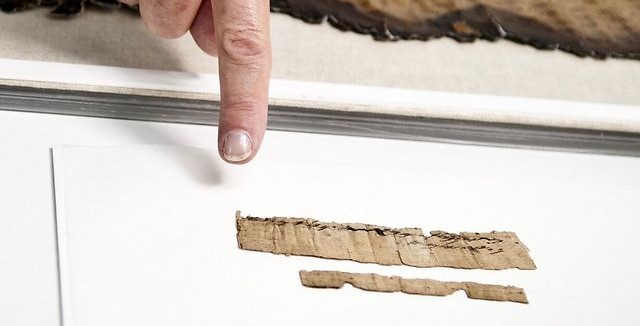An ancient papyrus from the First Temple period containing the earliest Hebrew mention of Jerusalem outside the Bible was unveiled by the Israel Antiquities Authority on Wednesday.
The document is from the 7th century BCE, according to radiocarbon dating, making it one of three existing Hebrew papyri from that time period, The Times of Israel reported. It is the first non-biblical source to mention Jerusalem from that time, and predates the Dead Sea Scrolls by several centuries.
The papyrus measures 4.3 inches by 1 inch and describes the shipment of two wineskins to Jerusalem. “From the female servant of the king, from Naharata [a place near Jericho] two wineskins to Jerusalem,” the text reads. According to the IAA, the Naharata mentioned in the text is the same location “that is referred to in the description of the border between Ephraim and Benjamin in Joshua 16:7: ‘And it went down from Janohah to Ataroth, and to Naʽarat, and came to Jericho, and went out at Jordan.'”
The fact that the shipment was recorded on papyrus rather than cheaper pottery shards suggests that it was sent to someone prominent. Israel Prize-winning biblical scholar Shmuel Ahituv said that the term “female servant of the king” indicates that an important woman sent the wineskins to Jerusalem, the capital of the Judean Kingdom.
According to Achituv, the Hebrew spelling of Jerusalem in the document omits an extra character and is pronounced “Yerushalem,” in agreement with all but four biblical mentions of the city, rather than the more modern version “Yerushalayim.”
Amir Ganor, head of the IAA’s antiquity theft prevention division, said that the papyrus document came from a cave in Nahal Hever, located in the Judean Desert. It is believed that the dry, cool conditions inside the cave allowed the papyrus fragment to be preserved for so long.
Last week, the Israel Antiquities Authority announced the discovery of the site where the Romans breached the city walls of Jerusalem prior to the destruction of the Second Temple.
The existence of a Jewish Temple is, in the words of Brown University historian Michael Satlow last year, “as historically certain a fact as one can get.” These two recent finds are the latest confirmations of the deep Jewish historical connection to Jerusalem. This history was challenged by UNESCO, the cultural organization of the United Nations, in a Palestinian-drafted resolution that was adopted earlier this month.
[Photo: Shai Halevi / Israel Antiquities Authority ]




